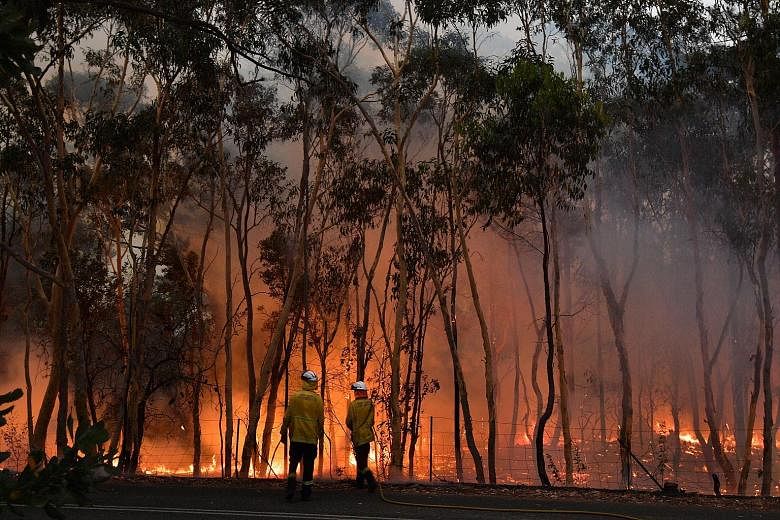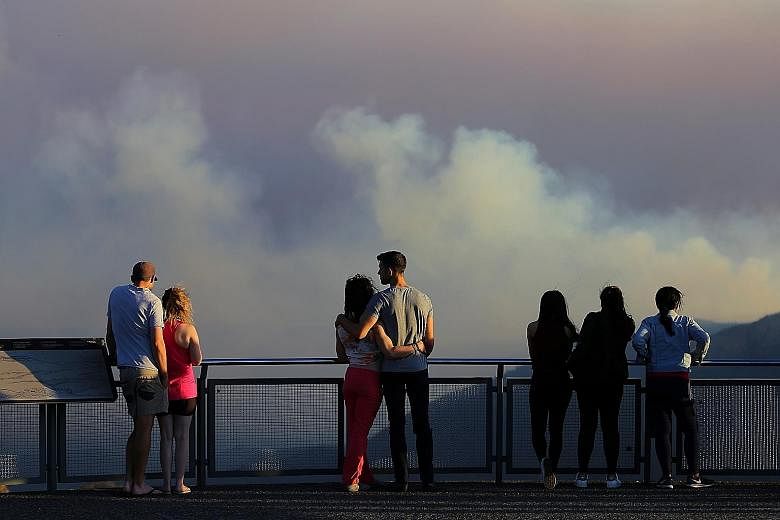Thousands of firefighters have been desperately battling hundreds of blazes across eastern Australia in recent days - including a huge front on Sydney's doorstep - yet this is only the beginning of the country's annual bush fire season.
The fires raging across the country's south-east are expected to worsen this week and are surrounding the outskirts of Sydney, which is facing a blaze that is larger than the city itself. The fires have left a blanket of thick grey smoke across the city, which has experienced record levels of hazardous air pollution.
In the state of New South Wales (NSW), over 2.1 million ha of bushland - almost 30 times the size of Singapore - have been destroyed in recent weeks. Six people have died and almost 700 houses have been lost. But the authorities yesterday said the worst may be yet to come as no serious rainfall is expected until late next month or later. The next big test will be on Tuesday, when temperatures in parts of the state will be more than 40 deg C.
"We've got very significant potential to see a lot more countryside, a lot more communities, being impacted by fire as we go into the typically hotter months of the year," Mr Shane Fitzsimmons, the commissioner of the state's Rural Fire Service (RFS), told Channel Nine.
"It's a tough couple of months ahead yet and we've already seen the horrific consequences of fire so far this season."
In Australia, bush fires have long been a common occurrence in the warmer months. Much of the bushland is dense, allowing flames to spread quickly, especially after long dry periods. But this year's blazes have come earlier than usual and, in many regions, have been among the largest and most intense on record.
At the small township of Bawley Point south of Sydney, residents last week described flames as high as 30m that threatened to destroy the entire community. At the last moment, as firefighters fought to protect homes, favourable winds diverted the flames.
RFS volunteer Bryan Coombes, who has fought fires in the region for 30 years, agreed with residents that the town had never seen a fire as large as last week's. He told The Sydney Morning Herald: "We kept being pushed back and pushed back because the fire kept burning."
Though the danger was eventually averted, the authorities said fires in the area could double in size.
-
2.1m
Hectares of bushland - almost 30 times the size of Singapore - that have been destroyed in recent weeks in the state of New South Wales.
Other states have also been facing serious bush fires. The Queensland Fire and Emergency Services said 207,000ha of land has burnt in the state in recent weeks. Over 40 fires are burning across the state, which has seen record temperatures.
The fires in Australia, which began before summer started, have followed a run of hot, dry weather and occurred as much of the country is in the grip of a severe drought.
On Friday, five fires north of Sydney combined to form a 60km front spanning 250,000ha. Calmer and cooler conditions yesterday helped firefighters to control blazes.
In a fire-hit region of south-west Sydney, Mr Scott Bruce recounted saying farewell to his wife and children, who fled for safety as he stayed to protect the house. He said he was less worried about the main fire front than falling embers, which could easily set fire to his home.
"It's not so bad when you see the glow," he told ABC News. "It's when those embers start dropping that you wonder where a spot might start."
In recent days, the smoke has led to eerie scenes as a heavy fog-like haze descended over Sydney. Many people have stayed indoors, and others wore surgical masks on the streets. At times, the air pollution reached levels equivalent to smoking about 30 cigarettes a day.
The NSW government said it was the longest period of poor air quality on record. From Nov 11 to Dec 5, there were 25 days of hazardous air quality. The haze is expected to continue until at least Tuesday.
The disaster has prompted calls to take greater action to combat climate change. Scientists have long warned that global warming is causing hotter, drier conditions in parts of Australia that will raise the risk of more frequent and severe fires, particularly across the southern and eastern parts of the country.
Analysts have criticised Prime Minister Scott Morrison for failing to adopt a comprehensive policy to reduce emissions, noting that Australia is not on track to meet its internationally agreed emissions targets.
Mr Morrison said last month that he accepted global warming was worsening the overall fire season, but claimed Australia cannot by itself affect outcomes as it contributes only 1.3 per cent of global emissions.
Meanwhile, NSW firefighters are becoming exhausted. Thousands have worked for hours on end, including through the night. Despite being reinforced by teams from other states and countries, including New Zealand, the United States and Canada, there are concerns that crews are being overworked.
Yet many will need to keep working through the weeks and months ahead.


